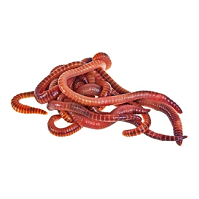Garden-friendly red worms: For organic waste solutions
Whatever You Need to Learn About Red Wigglers for Composting
Red wigglers, or Eisenia fetida, play a critical role in the world of composting, changing organic waste right into useful soil amendments. The process of establishing up a worm container and maintaining it can pose obstacles.
What Are Red Wigglers?

(Lake Rhodhiss Bait)
Indigenous to The United States and copyright, red wigglers are surface-dwelling microorganisms that favor moist, cozy habitats abundant in decaying organic matter. Their diet consists largely of rotting plant material, food scraps, and various other organic debris, which they take in and break down successfully. As they digest this product, they create nutrient-rich castings that boost soil fertility.
Red wigglers are hermaphroditic, having both male and women reproductive body organs, and can duplicate promptly under optimum problems. Generally, red wigglers are crucial contributors to the procedure of reusing organic waste into beneficial garden compost.
Benefits of Using Red Wigglers
Utilizing red wigglers in composting systems uses many advantages that improve both the efficiency of waste management and the quality of the resulting compost. These worms, scientifically referred to as Eisenia fetida, are specifically efficient at damaging down raw material, turning cooking area scraps and lawn waste into nutrient-rich compost at an accelerated price.
Among the main benefits of utilizing red wigglers is their capacity to take in big quantities of natural product, frequently processing their weight in food waste daily. This high consumption rate brings about quicker decay and reduces the quantity of waste sent out to garbage dumps. Additionally, the spreadings created by red wigglers are rich in crucial nutrients, valuable bacteria, and enzymes, making them an excellent plant food for gardens and plants.
In addition, red wigglers flourish in a range of atmospheres, making them adaptable for both indoor and outside composting systems - red wigglers. Their existence in a compost bin assists to aerate the product, stopping smells and advertising a healthy and balanced composting process. In general, utilizing red wigglers not only contributes to effective waste management however additionally sustains lasting gardening practices through the production of high-grade compost
(red wigglers for sale near me)
Establishing Your Worm Bin
To successfully establish a worm bin, it is necessary to select an appropriate container that meets the needs of red wigglers while offering a favorable setting for composting. A suitable bin can be made from plastic, wood, or steel, with a capability of a minimum of 1 square foot for every extra pound of worms.
Ensure the container has sufficient drainage holes to stop excess dampness, as red wigglers thrive in a damp, but not waterlogged, atmosphere. red wigglers. The bin should additionally be ventilated to provide enough air flow, preventing anaerobic problems that could damage the worms
A suitable location for the worm bin is an awesome, dark area, without direct sunlight and severe temperatures, as red wigglers choose a temperature series of 55 to 77 levels Fahrenheit.
Before introducing the worms, prepare bed linens products such as shredded paper, cardboard, or coconut coir, which will supply both habitat and food. Moisten the bedding gently to produce a welcoming environment for the worms. Finally, take into consideration putting a cover on the container to maintain moisture and decrease bugs, while guaranteeing it can be easily eliminated for upkeep.
Feeding and Treatment Standards
Feeding red wigglers is a critical aspect of maintaining a healthy and balanced composting system. These worms flourish on a varied diet plan, primarily made up of organic products such as vegetables and fruit scraps, coffee premises, and smashed eggshells. It is necessary to prevent feeding them meat, dairy products, and oily foods, as these can develop undesirable smells and attract parasites.
When presenting food to your worm container, slice or shred materials into smaller items to facilitate quicker disintegration. Start with percentages to assess the worms' consumption price, slowly increasing the amount as they adapt. It is recommended to alternating feeding areas within the container to encourage detailed mixing and aeration of the compost.

Troubleshooting Common Issues
Preserving a thriving worm composting system can occasionally present challenges that need focus and troubleshooting. Usual concerns consist of an undesirable odor, which often suggests overfeeding or the existence of anaerobic conditions. To correct this, minimize the quantity of food added and make sure appropriate aeration by blending the bed linens material.
An additional regular trouble is the escape of worms from the bin. This can happen because of too much dampness or improper ecological problems. Regularly check the wetness levels, intending for a damp however not soggy consistency, and maintain ideal temperatures between 60-80 ° F(15-27 ° C )to produce a comfortable environment for your red wigglers.
Bugs, such as fruit flies, can also attack worm bins. red wigglers. To fight this, cover food scraps with a layer of bed linen or shredded paper to discourage flies from laying eggs. Furthermore, make sure that any type of food included is fresh and devoid of mold and mildew, which can attract unwanted insects
Lastly, if your worms seem inactive, look for stress and anxiety aspects such as temperature variations or insufficient dampness. Attending to these common concerns will aid preserve a healthy and balanced and efficient worm composting system.
Conclusion
In recap, red wigglers, or Eisenia fetida, play an essential role in sustainable waste administration with vermicomposting. Correct setup and maintenance of a worm bin, along with adherence to feeding standards, make certain a growing community that reduces landfill payments.